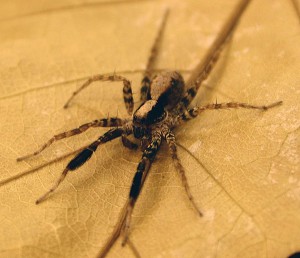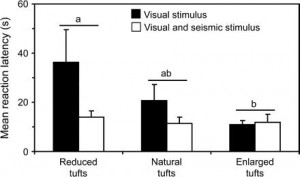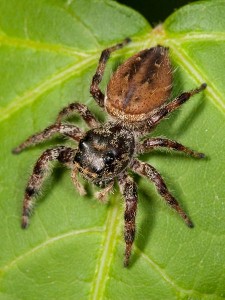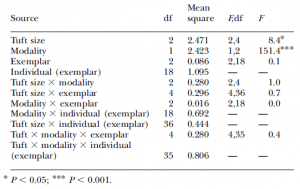Signal detection theory states that animals will use their own set of signals (courtship signals) to attract a mate by standing out from background interference. These set of signals can be implemented at the same time to produce complex signals. Complex signals are effective because they allow an increased chance for the species to be noticed and lowers the time that it takes for them to be noticed (this is called reaction latency). The trade-off is that these complex signals can be easily detected by predators. Wolf spiders of the genus Schizocosa use complex courtship signals. Wolf spiders use concurrent visual signals such as the tapping of its forelegs and its demonstration of its tufts of bristles on those forelegs as courtship signals along with the seismic component by tapping its body against a surface in their leaf-litter habitat. In previous laboratory studies, females prefer males with larger and more vigorous signal attributes. This means that these males will mate more often and produce offspring with similar traits. The increased courtship signal strength could also possibly lead to increased predation as well. Roberts, Taylor and Uetz conducted video and seismic playback experiments to investigate if these complex signaling traits that result in increased intersexual communication are associated with an increased rate of predation.
Jumping spiders (Phidippus clarus) were chosen to be the predator under study for this experiment because they hunt using both visual and seismic cues from prey. Jumping spiders where also chosen because their period of foraging activity overlaps with the period in which male wolf spiders (Schizocosa ocreata) are displaying courtship signals. Only the female jumping spiders were chosen because of their aggression and quick response to prey.

Male wolf spider (Schizocosa ocreata). Tufts are the black bristle-like structures on the two frontal legs. Picture taken by Uetz.
Jumping spiders responded to the wolf spider courtship behavior in 124 of 126 trials within a five minute period. Reaction latency to the wolf spider courtship signal was significantly affected by variation in tuft size and the complexity of the signal (seen in table 1 and figure 1). The jumping spiders oriented themselves to prep for an attack sooner when both the visual and seismic signals were present. Figure 1 shows how the jumping spiders also responded sooner to larger tuft sizes than smaller tuft sizes. This proves that complex signaling (with large tufts) does correlate with an increase in the amount of predation.

Figure 1: Jumping Spider’s (Phidippus clarus) reaction latency to visual and visual and seismic stimuli for varying tuft sizes in wolf spiders (Schizocosa ocreata).
The increase in size of a visual signaling ornament (tufts) and the addition of multiple sensory cues (visual and seismic) both result in an increased chance of detection by predators. Wolf spider males invest in larger visual signal to increase sexual success but the larger the visual signal the greater the risk of predation. An increase in the complexity of the signal (visual + seismic) lowered the reaction time of Jumping Spiders which suggests an increase in predation as well. Elaborate, complex signals could arise through sexual selection or constraints from the environment selecting clearer, detectable signals. This will unfortunately increase predator detection as well. What other species are at risk due to complex courting signals?!
Sources:
“Phidippus Clarus.” Wikipedia. Wikimedia Foundation, 15 Mar. 2014. Web. 28 Mar. 2014.
Roberts, J.A., P.W. Taylor, and G.W. Uetz. 2006. Consequences of complex signaling: predator detection of multimodal cues. Behavioral Ecology 18:236-240.
University of Cincinnati. “Inside Uptown.” UC Magazine. University Relations, Apr. 2011. Web. 28 Mar. 2014.


